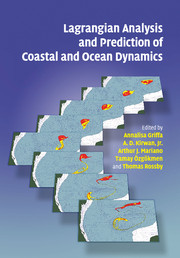Book contents
- Frontmatter
- Contents
- List of contributors
- Preface
- 1 Evolution of Lagrangian methods in oceanography
- 2 Measuring surface currents with Surface Velocity Program drifters: the instrument, its data, and some recent results
- 3 Favorite trajectories
- 4 Particle motion in a sea of eddies
- 5 Inertial particle dynamics on the rotating Earth
- 6 Predictability of Lagrangian motion in the upper ocean
- 7 Lagrangian data assimilation in ocean general circulation models
- 8 Dynamic consistency and Lagrangian data in oceanography: mapping, assimilation, and optimization schemes
- 9 Observing turbulence regimes and Lagrangian dispersal properties in the oceans
- 10 Lagrangian biophysical dynamics
- 11 Plankton: Lagrangian inhabitants of the sea
- 12 A Lagrangian stochastic model for the dynamics of a stage structured population. Application to a copepod population
- 13 Lagrangian analysis and prediction of coastal and ocean dynamics (LAPCOD)
- Index
- Plate section
- References
2 - Measuring surface currents with Surface Velocity Program drifters: the instrument, its data, and some recent results
Published online by Cambridge University Press: 07 September 2009
- Frontmatter
- Contents
- List of contributors
- Preface
- 1 Evolution of Lagrangian methods in oceanography
- 2 Measuring surface currents with Surface Velocity Program drifters: the instrument, its data, and some recent results
- 3 Favorite trajectories
- 4 Particle motion in a sea of eddies
- 5 Inertial particle dynamics on the rotating Earth
- 6 Predictability of Lagrangian motion in the upper ocean
- 7 Lagrangian data assimilation in ocean general circulation models
- 8 Dynamic consistency and Lagrangian data in oceanography: mapping, assimilation, and optimization schemes
- 9 Observing turbulence regimes and Lagrangian dispersal properties in the oceans
- 10 Lagrangian biophysical dynamics
- 11 Plankton: Lagrangian inhabitants of the sea
- 12 A Lagrangian stochastic model for the dynamics of a stage structured population. Application to a copepod population
- 13 Lagrangian analysis and prediction of coastal and ocean dynamics (LAPCOD)
- Index
- Plate section
- References
Summary
Introduction
For centuries, our knowledge of the oceans' surface circulation was inferred from the drift of floating objects. Dramatic examples include wrecked Chinese junks and Japanese glass fishing balls which have washed ashore on the US west coast (Sverdrup et al., 1942). Such observations could only provide crude ideas of gyre-scale currents, as there was no way to tell the exact beginning (in time or space) of the drifter's journey, or the trajectory it had taken. Currents can be more accurately inferred from ship drift measurements. A ship's motion relative to the surrounding water is measured by the ship log; its absolute motion is estimated from navigational fixes. In the absence of wind and the “sailing” force of flow around the hull and keel, the difference between absolute and relative motion is the velocity of the water (the current). However, due to relatively large navigational errors in the mostly pre-GPS data set of ship drifts, such current estimates can have errors of O(20 cm/s) (Richardson and McKee, 1984). In addition, a drifting ship is exposed to both currents and wind, making the relative role of the two forces difficult to separate. Comparison of ship drifts with less windage-prone measurements have revealed significant differences in the tropical Pacific (Reverdin et al., 1994) and Atlantic (Richardson and Walsh, 1986; Lumpkin and Garzoli, 2005). To reduce the wind force, investigators in the early 1800s began using drift-bottles to map surface currents.
- Type
- Chapter
- Information
- Publisher: Cambridge University PressPrint publication year: 2007
References
- 162
- Cited by



